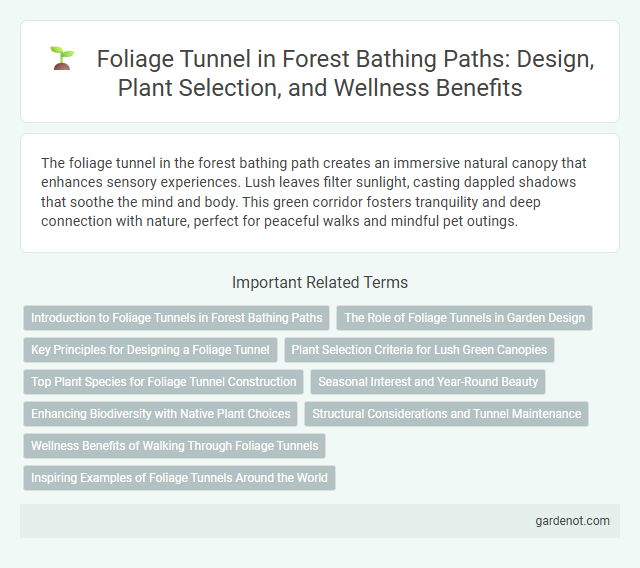The foliage tunnel in the forest bathing path creates an immersive natural canopy that enhances sensory experiences. Lush leaves filter sunlight, casting dappled shadows that soothe the mind and body. This green corridor fosters tranquility and deep connection with nature, perfect for peaceful walks and mindful pet outings.
Introduction to Foliage Tunnels in Forest Bathing Paths
Foliage tunnels in forest bathing paths create immersive natural corridors by intertwining tree branches and leaves overhead, enhancing the sensory experience of walking through the forest. These tunnels increase exposure to diverse plant species and promote relaxation by enveloping visitors in calming shades of green and filtered sunlight. The structural design of foliage tunnels supports biodiversity and encourages mindful exploration during forest therapy sessions.
The Role of Foliage Tunnels in Garden Design
Foliage tunnels create immersive green corridors that enhance spatial depth and sensory experience in garden design. By guiding visitors through dense, living archways, these tunnels foster a strong connection with nature while promoting relaxation and mindfulness. Integrating diverse plant species within foliage tunnels supports biodiversity and seasonal visual interest, elevating the ecological function and aesthetic appeal of outdoor spaces.
Key Principles for Designing a Foliage Tunnel
Designing a foliage tunnel for a forest bathing path centers on maximizing immersion through dense, layered plantings that create a natural canopy and shaded enclosure. Selecting native, seasonal species enhances sensory engagement with changing colors, textures, and fragrances throughout the year. Incorporating winding pathways and varied plant heights promotes a sense of discovery and tranquility essential for mindfulness in nature.
Plant Selection Criteria for Lush Green Canopies
Plant selection criteria for a foliage tunnel prioritize species with dense, broadleaf canopies that maximize shade and create an immersive green environment. Native and fast-growing plants such as maples, beeches, and hornbeams are preferred for their vibrant leaves and seasonal color variations, enhancing the visual and sensory experience. Resistance to local pests, adaptability to soil types, and low maintenance requirements ensure the tunnel's sustainability and lushness year-round.
Top Plant Species for Foliage Tunnel Construction
The top plant species for foliage tunnel construction include fast-growing vines such as Wisteria sinensis, Clematis armandii, and Trachelospermum jasminoides, known for their dense leaf cover and attractive blooms. Evergreen species like Hedera helix (English ivy) provide year-round greenery, while deciduous options such as Parthenocissus quinquefolia (Virginia creeper) add vibrant seasonal color and natural shade. Selecting plants with vigorous growth habits and adaptability to local climate ensures a lush, immersive canopy ideal for a serene forest bathing path.
Seasonal Interest and Year-Round Beauty
The foliage tunnel transforms with each season, showcasing vibrant blooms in spring, lush greenery in summer, fiery hues in autumn, and delicate bare branches in winter, creating a dynamic sensory experience. This natural canopy attracts diverse wildlife year-round, enhancing the path's ecological value and visitors' connection to nature. The continuous cycle of seasonal changes ensures the foliage tunnel remains a breathtaking highlight for forest bathing throughout the year.
Enhancing Biodiversity with Native Plant Choices
The foliage tunnel on the forest bathing path is designed to enhance biodiversity by incorporating a variety of native plant species such as oak, maple, and dogwood, which support local wildlife and pollinators. These native plants create a vibrant ecosystem by providing essential habitats, food sources, and nesting opportunities for birds, insects, and small mammals. Strategically planting diverse native flora strengthens ecological resilience and promotes sustainable forest health along the path.
Structural Considerations and Tunnel Maintenance
The foliage tunnel requires a robust support structure, typically using weather-resistant materials such as treated wood or galvanized steel, to withstand varying weather conditions and ensure safety. Regular maintenance includes pruning overgrown branches, inspecting for structural integrity, and managing plant health to prevent decay or damage. Consistent monitoring of soil moisture and pest control is essential to preserve both the tunnel's aesthetic appeal and longevity.
Wellness Benefits of Walking Through Foliage Tunnels
Walking through foliage tunnels enhances mental clarity and reduces stress by immersing individuals in natural surroundings rich in phytoncides and negative ions. The dense canopy creates a microclimate that cools air temperature, improving respiratory function and boosting the immune system. Exposure to filtered sunlight and vibrant greenery promotes relaxation, lowers blood pressure, and elevates mood through increased serotonin levels.
Inspiring Examples of Foliage Tunnels Around the World
Foliage tunnels such as the Dark Hedges in Northern Ireland, formed by intertwining beech trees, captivate visitors with their ethereal beauty and historical significance. Japan's Metasequoia-lined Path in Aomori offers a tranquil escape through towering, vibrant green arches, ideal for forest bathing and mindfulness. These inspiring examples demonstrate how natural architecture enhances sensory immersion, promoting relaxation and a deep connection to nature.
Foliage tunnel Infographic

 gardenot.com
gardenot.com